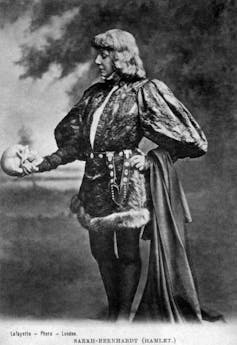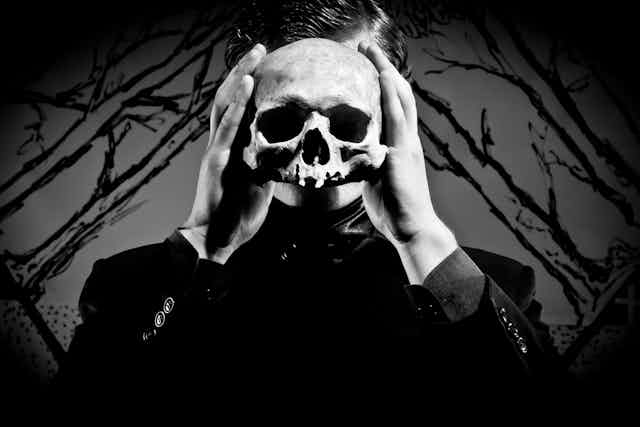The image of a man holding a skull while ruminating upon mortality will always call Hamlet, and Shakespeare, to mind. How appropriate then, that four centuries after it was first laid beneath the earth, Shakespeare’s skull may be missing from his tomb. Then again, it may not. A radar survey of the poet’s Stratford grave in March has only deepened the mystery over what lies beneath his slab. As the world prepares to celebrate the sombre yet irresistible anniversary of Shakespeare’s death on April 23, how much do we know how about his own wishes for the fate of his remains?
The resuscitation of an improbable Victorian anecdote about 18th-century grave robbers grabbed the headlines, but all we know for certain is that the upper part of the burial has been disturbed in some way. Confirming the presence or absence of Shakespeare’s head would require the physical opening of his grave. This is unlikely to take place anytime soon, as the vicar of Holy Trinity – the church within which he is buried – has confirmed, thanks to the four lines of forbidding verse inscribed upon the ledger stone:
Good frend for Iesus sake forbeare,
To digg the dvst encloased heare,
Bleste be ye man yt spares thes stones,
And curst be he yt moves my bones.

In one of his sonnets, Shakespeare boasts that his “powerful rhyme” will outlive marble monuments and ostentatious tombs. At Holy Trinity his verse has had the power to ensure the survival of his own simple monument. Since the 19th century, numerous campaigns to open the grave have run aground on this uncompromising quatrain. Indeed, it would be difficult to find four other lines by Shakespeare that have had such power to influence events centuries after his death. Poetry, WH Auden said, makes nothing happen. In this case, poetry is ensuring that literally nothing happens to Shakespeare’s grave.
Many must have wished that Shakespeare’s final words to posterity consisted of something more than a curt demand to be left alone. Perhaps for this reason, most scholars and editors have been highly reluctant to ascribe these verses to Shakespeare himself. The magisterial biographer, Samuel Schoenbaum, dismissed the quatrain as “a conventional sentiment in commonplace phrases” – and deemed it the work of a local hack, perhaps specialising in funerary inscriptions. Following this lead, Holy Trinity reassures visitors that curses on gravestones were “not at all uncommon at the time”.
But in fact, though the verse may be halting, it is anything but conventional. No researcher has been able to produce a comparable inscription from a 16th or 17th-century English grave. A few early modern epitaphs (such as John Skelton’s memorial to the Countess of Richmond in Westminster Abbey) threaten divine punishment against irreligious vandals who might deface the monument or the inscription itself. Shakespeare’s epitaph, by contrast, threatens to curse a church official, the sexton, who in the ordinary pursuit of his duties would periodically open graves to make room for further burials. In this respect, it is both highly audacious and very probably unique.
The anxiety about exhumation expressed on Shakespeare’s slab may be unusual in the context of an epitaph, but it resonates powerfully with the content of his plays. A surprising number of the tragedies and histories feature disturbing scenes involving exhumation or interference with the bodies of the dead. In Richard III, the long-dead body of Henry VI bleeds afresh when brought face-to-face with its murderer. The heroine of Romeo and Juliet, buried alive in her ancestral crypt, fantasises that she may “madly play with my forefather’s joints”, and dash out her brains “with some great kinsman’s bone”.
Confronted with the ghost of Banquo, Macbeth assumes he is looking at an exhumed corpse:
If charnel-houses and our graves must send
Those that we bury back, our monuments
Shall be the maws of kites.

Most memorably, Hamlet watches a gravedigger wrench dry bones from a grave to make room for the body of Ophelia: “That skull had a tongue in it and could sing once. How the knave jowls it to the ground!” The indignities meted out to the bodies of the dead seem to unsettle the Prince of Denmark more than the fact of death itself.
With the possible exception of John Donne, no other writer of Shakespeare’s age fantasised so persistently or so morbidly about the prospect of exhumation. It is no accident that his work is an emblem today in the image of a man gazing into the empty sockets of a disinterred skull. The suggestion that his own skull may have suffered Yorick’s fate in the hands of some 18th-century grave robber is almost too ironically appropriate.
Given the uniqueness of Shakespeare’s grave inscription, and the anxiety about the fate of the corpse evident in his plays, there is strong reason to believe that the verses on his slab are his own work, that they spell out his final wish. Whether we are obligated to respect his wishes is a separate question. But one thing is certain: when we find ourselves marking the 400th anniversary of his death by wondering over the whereabouts of his skull, we are dreaming Shakespeare’s nightmares for him.

